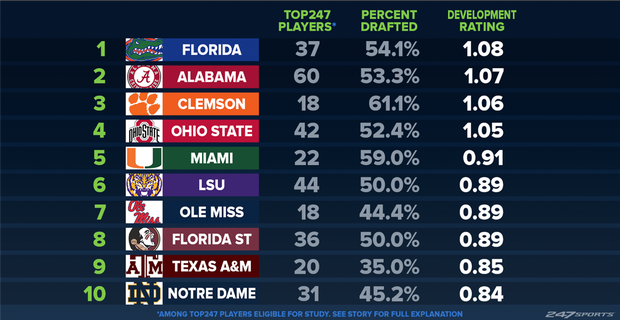https://247sports.com/college/florida-state/Article/College-football-development-Top247-2019-NFL-Draft-Alabama-Clemson-Florida-131413816/

Recruiting is college football’s lifeblood.
Excuse the cliché. There just isn’t a more succinct way to describe it. From now until robots or androids become the gladiators of choice, college football will be defined by the ability acquire and cultivate talent: Every national title game participant since 2002 featured at least one five-star prospect on its roster.
Development, the labor of transforming talent to production, is what closes the gap between those with recruiting riches and those without. It can also serve as a wedge that separates powerhouses from everyone else.
Those teams have their moments, but all of them (perhaps with the exception of Oklahoma) had severe swoons in play. The teams best protected against that like Florida State, Georgia and Notre Dame had the recruiting base – 30-plus Top247 players – to endure some busts. Even then, each experienced at least one season with eight or fewer wins within the last three years. In the Sooners’ case, landing a pair of transcendent transfer quarterbacks (and a potentially a coach) can make up for a lot.
247Sports examined the first five years of Top247 data in order to determine how top programs nationally have developed four and five-star players. Those classes, 2010-14, span a full spectrum of eligibility across a five-year period. There are some holdouts from the 2014 class (fifth-year seniors). For the most part, however, the 1,235 prospects have exhausted their eligibility or filtered out of college football.
To fairly access a successful development, 247Sports created a “Development Rating.” It's a measure that takes into account the total number of Top247 prospects a program had along with where/if those players were drafted (3 points for 1st rounders, 2 points for 2nd-3rd, 1 for 4th-7th), dividing the total number of prospects by the point total to create the rating. This removes any advantage created by a program’s ability to recruit an overwhelming number of Top247 players. It also rewards programs that produce more first- and second-day picks. The NFL often will draft late-round fliers on talent alone – think Kahlil McKenzie in the sixth round last year.
To more accurately represent how a program develops players, 247Sports removed four categories of prospects from the data: 1. Players who were dismissed. 2. Players who didn’t qualify. 3. Players who medically retired. 4. Players who transferred after two or fewer seasons on campus. If a player stayed three years and transferred, they count against a team’s 'not drafted' tab. If a player transferred and was drafted elsewhere, they count for the team to which they transferred.
Lastly, Top247 players don’t fully speak to a program’s ability to develop. The more impressive examples are often when teams find undervalued talent and shape it into NFL potential. That’s why schools like TCU, Wisconsin and Boise State have found outsized success since 2000. Yet, as we annually salivate over four and five-star prospects, this study is meant to spotlight the programs that do the most with those players.
Even considering those outside factors, the differences between schools like North Carolina (36.4 percent of 11 Top247 prospects drafted) and Florida State (50 percent of 36 Top247 players drafted) are clear. There’s a reason the Seminoles have six 10-win seasons this decade while the Tar Heels claim just one.
No comments:
Post a Comment